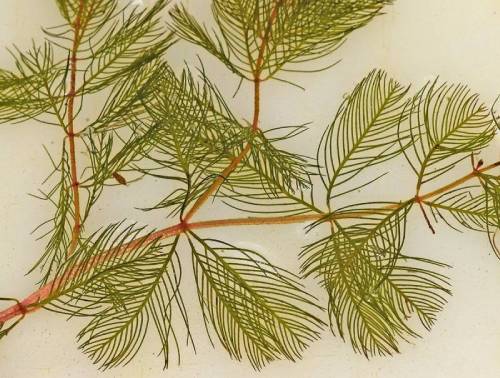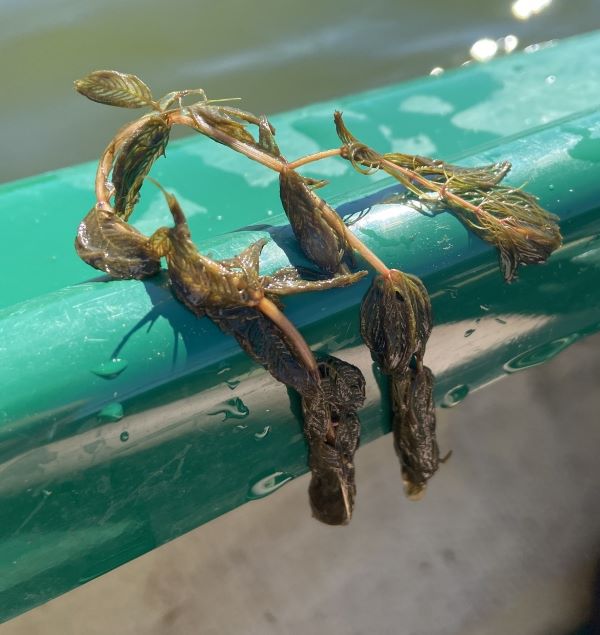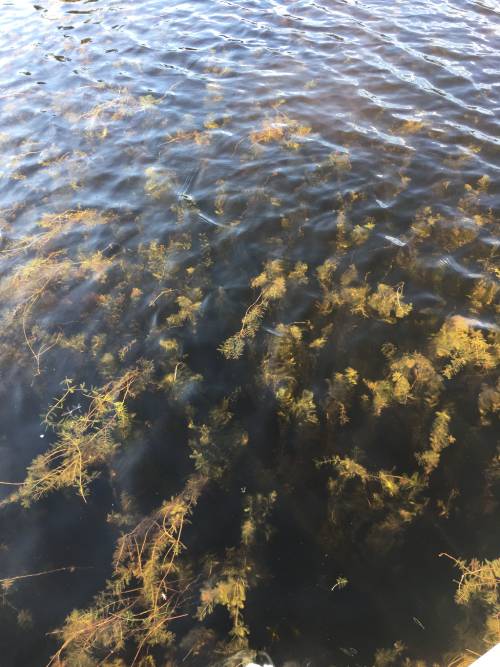Eurasian watermilfoil identification and control
About this weed
Eurasian watermilfoil is a non-regulated Class B noxious weed. This means due to how widespread it is, property owners are not required to control this species on their property, though it is encouraged.
Eurasian watermilfoil is also on the Washington quarantine list, and it is illegal to buy, sell, or offer it for sale in the state.
Eurasian watermilfoil is known as Myriophyllum spicatum or spiked water-milfoil and it is in the watermilfoil family.

Why it's a problem
Eurasian watermilfoil is a submerged/underwater aquatic plant that can alter aquatic ecosystems. It forms dense mats that shade out other aquatic plants, degrades water quality, inhibits water flow, and impacts recreational activities. Eurasian watermilfoil is present in many lakes in King County. The plant spreads through plant fragmentation and is especially common in lakes with public boat launches. Boaters should clean all plant material from boats and trailers before moving between lakes. This will keep the plant from spreading further. If found early enough, control of Eurasian watermilfoil it may be possible.
Plant description
Eurasian watermilfoil is a perennial (2+ year lifecycle)plant that grows in water to 20 feet deep. The plant forms tangled underwater stands and dense floating mats.
Leaves are in whorls (groups) of four, and are feathery, with generally more than 14 leaflet pairs per leaf. Leaves often appear squared‐off at the tip. Leaves usually collapse against the stem whenthe plant is pulled from the water. Stems of Eurasian watermilfoil are long, branched near the surface, and usually reddish (newer growth is greener). Flowers are tiny and borne on reddish spikes above the water surface.
Eurasian watermilfoil plants spread by plant fragment or rhizome (root system that spreads outwards and can grow new stems).
Eurasian watermilfoil is native to Europe and Asia.






Be aware of look-alike plants
Eurasian watermilfoil is often confused with:
Northern milfoil (Myriophyllum sibiricum), a native plant. The native look-alike generally has fewer than 14 leaflet pairs per leaf, leaving larger gaps between leaflets. The native milfoils also tend to retain their shape when pulled from the water rather than collapsing against the stem.
There are many other milfoil (Myriophyllum) species that may appear similar to Eurasian watermilfoil. Consult an expert if you are not sure what species you have. When in doubt, take photos and share them with us or report them on iNaturalist.
Eurasian watermilfoil on left and northern milfoil (native) on right in both photos below.


What to do if you find it
Property owners are required to control Eurasian watermilfoil on lands that they manage. Please notify us if you see Eurasian watermilfoil growing in King County. Our program staff can provide the property owner or appropriate public agency with site-specific advice on how best to remove it. We map all known locations of regulated noxious weeds such as Eurasian watermilfoil in order to help us and others locate new infestations in time to control them.
This plant is often distributed through movement of watercrafts and water related equipment. Make sure you inspect your watercraft at the boat launch before entry and after exit to avoid spreading any invasive or nuisance aquatic plants or animals. See King County’s boating information web page for more information.
Control methods
We recommend using a combination of methods to control noxious weeds. In areas with few weeds, it is important to act quickly before they become harder to control. Make a long-term plan as it often takes several years to get rid of most weeds. Start in the least infested areas first and then move into more heavily infested areas.
For more in-depth control information, read our Best Management Practices (BMP) for Eurasian watermilfoil.
Before beginning any aquatic weed control work make sure you are following all applicable regulations. Regulations by the Washington State Department of Fish and Wildlife, Washington State Department of Ecology, as well as local Critical Area Ordinances and Shoreline Regulations will likely apply.
Prevention
Eurasian watermilfoil may be sold as an aquarium or water garden plant so be sure to check the scientific name of all plants before purchasing them, especially through the internet where companies may not be aware of Washington state laws. Never dispose of unwanted aquatic plants in waterways.
Eurasian watermilfoil is very difficult to control. Incomplete control methods such as cutting can lead to further spread of viable plant fragments. These plant fragments can re-grow and increase the infestation. The entire plants must be removed for control to be effective.
Manual control
Aquatic plant control that does not involve herbicide often requires a (free) permit. The rules and regulations for this type of removal will depend on your circumstance, please visit the WA Dept Fish and Wildlife for access to their Aquatic Plants & Fish Pamphlet and guidance on how to use it properly.
Eurasian watermilfoil can be hand-pulled. The entire plant plus its roots must be removed to be effective. Deep water work will require diving gear. This strategy works best on small infestations.
Mechanical control
Small infestations of Eurasian watermilfoil can be suctioned harvested by divers. The entire plant plus its roots must be removed to be effective. This activity will increase turbidity and lower water quality for a short period of time.
Chemical control
Stay safe when using herbicide:
- Always read the label before use.
- Wear a long-sleeved shirt, long pants, shoes, and eye protection.
- Follow state and local regulations.
Avoid spraying where there is a chance that herbicide will enter a waterway or wetland unless you are using a state-approved aquatic herbicide and have the required permits and licenses to do so. Use of pesticides in water is regulated in Washington state. See Washington Department of Ecology Aquatic Pesticide Permits for details. The herbicide 2,4-D is effective in low concentrations on Eurasian watermilfoil in the right conditions, although multiple years of application are needed for complete control. See the BMP document linked above the “manual control” section for the most up to date and specific method for chemical control of Eurasian milfoil.
For more information or a site-specific recommendation in King County, contact the noxious weed program. For information in other locations, contact your local weed board or extension office.
Disposal instructions
Manual/mechanical removal is not recommended. If you are only dealing with a few plants and manual removal is realistic, dispose of all plant parts in garbage.
Noxious Weed Disposal - Washington State Noxious Weed Control Board

 Translate
Translate